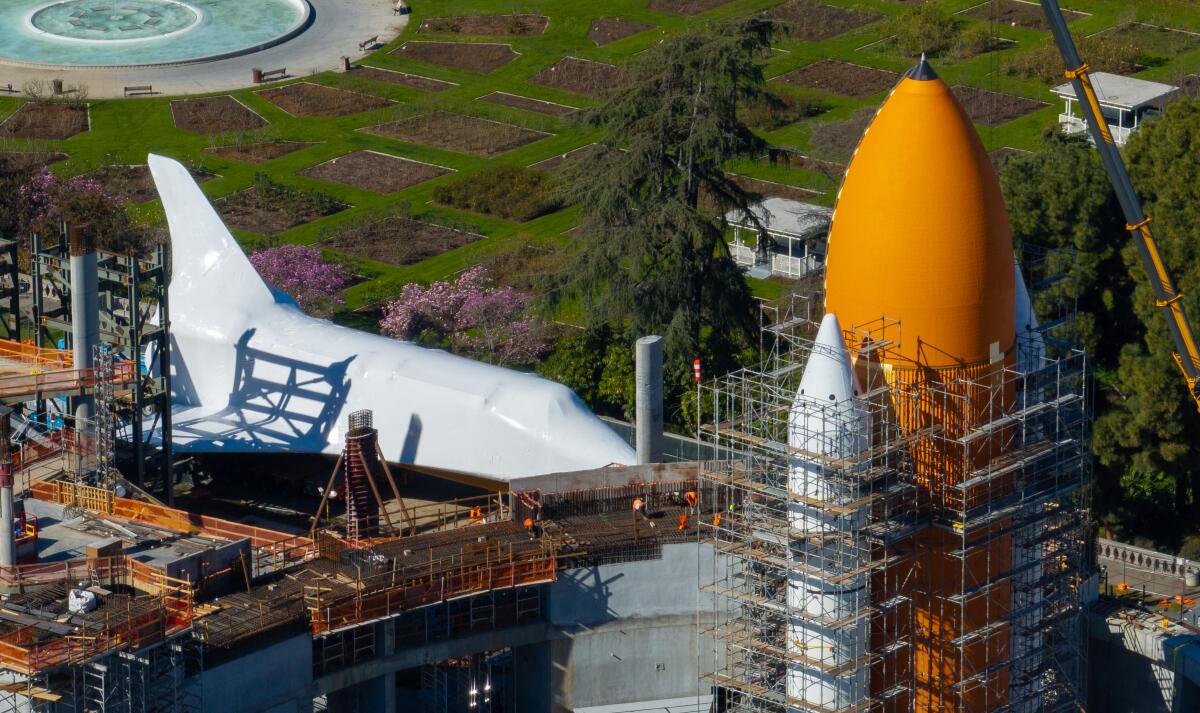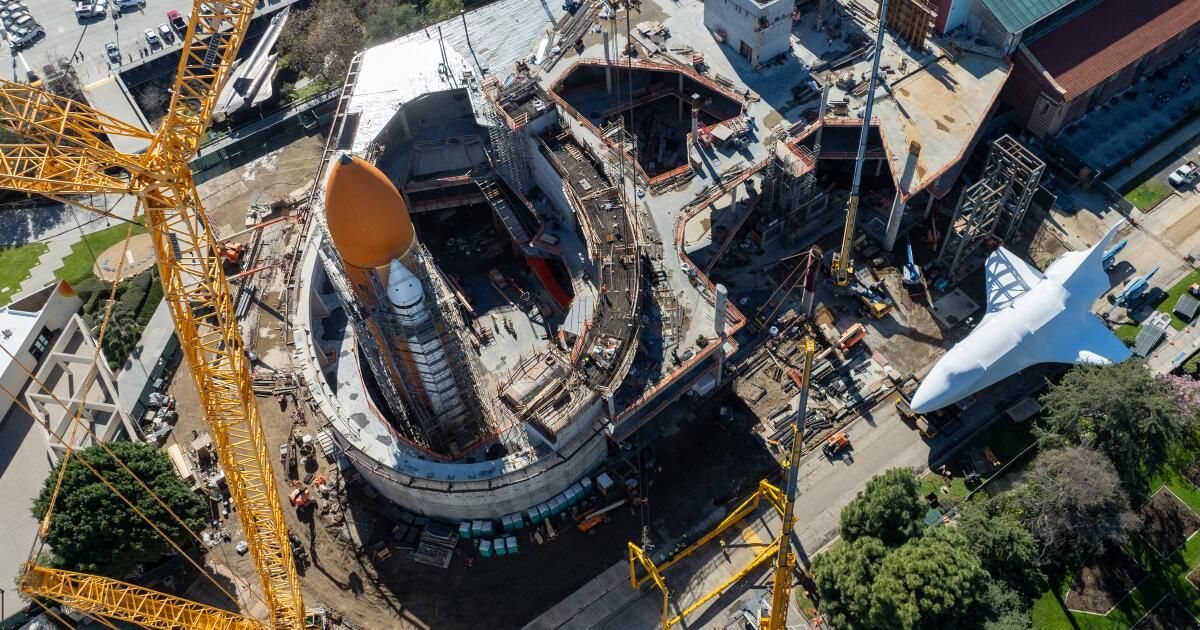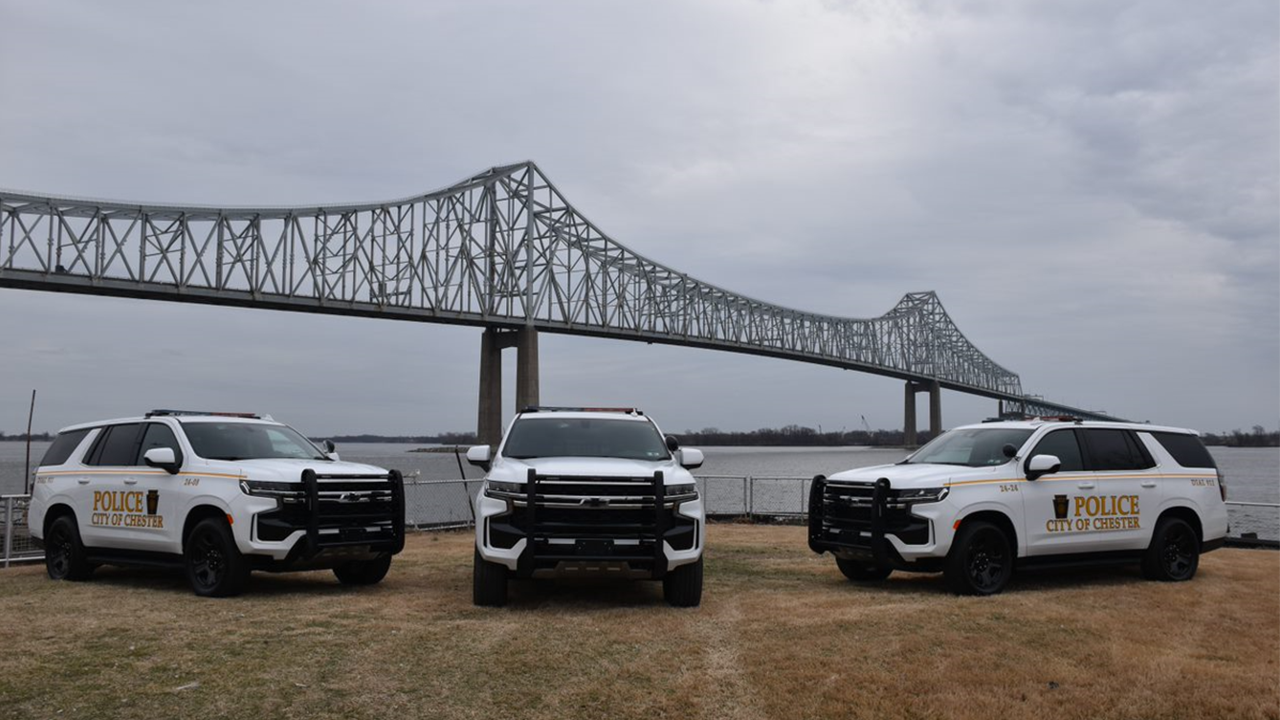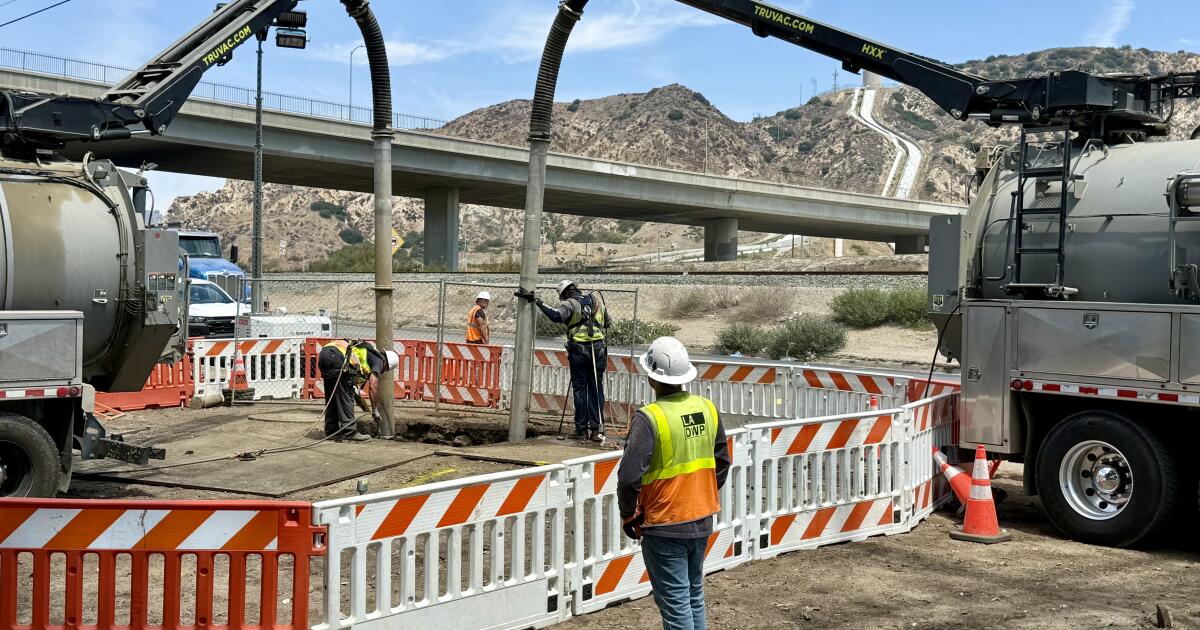Barring weather delays, the space shuttle Endeavor will perform its historic and final lift starting Monday night, a maneuver no other retired orbiter has performed.
Plans for the next move – putting the crown jewel of the new Samuel Oschin Air and Space Center in place – have been in the works for more than a decade. First, a pair of cranes will lift the shuttle from a horizontal to a vertical position; The spacecraft will be attached to a sling, a large metal frame that will support it during movement. An 11-story crane will lift Endeavor's tail, while a 40-story crawler crane, roughly the height of City Hall, will lift its nose.
Once the shuttle is pointed toward the stars, the shorter crane will disengage, leaving the taller crane to gently swing the orbiter into its final position and lower it to secure it with the giant orange external tank. The external tank is attached to two solid rocket boosters, which are connected to the foundation of the exhibit.
Once it is completed, and the rest of the museum is built in the coming years, Los Angeles will house the only retired space shuttle displayed in a complete layout as if ready for launch.
A file photo from 2012 shows the space shuttle Endeavor on the streets of Los Angeles en route to the California Science Center.
(Don Bartletti / Los Angeles Times)
The move will have two parts. The first, the so-called “soft matte”, is scheduled to begin around 10:00 p.m. on Monday and could take hours.
“That's the part of getting it up the building and closer to the orbiter,” said Jeffrey Rudolph, president of the California Science Center.
The second part will be to “capture” the Endeavor to the external tank.
“It's extremely delicate to get it in exactly the right position,” Rudolph said. “Place all attached hardware in the correct place on the orbiter. And several of the pieces inside the orbiter that it attaches to are very fragile, so they will do it very slowly.”
Once this is done, everything will need to be adjusted, Rudolph said, but the measure will effectively be complete. It is believed that by Thursday everything will be “hard coupled, meaning everything will be tightened and screwed together forever.” And he'll take off the sling and we'll say, 'Done,'” he said.
The schedule could change due to weather, as strong winds would force the transfer to be postponed.
Nothing should change after that until the museum opens the doors to the payload bay in a few years, when the Endeavor is ready for public display, Rudolph said.
There are different challenges to lifting the shuttle than to lifting the external tank, which was completed earlier this month. The tank is so large that when it was lowered, there was less than an inch of space between it and the rocket's solid boosters.
With the Endeavor orbiter, the last space shuttle ever built, crews will need to maneuver an object with a wingspan of 78 feet and get “everything absolutely level and aligned correctly and extremely smoothly,” Rudolph said.
“There are some places where there are some challenging parts when lowering it because of the tight fit with the wings and the vertical stabilizer,” he said. “And then the challenge is to get the orbiter – 'capture' it – to the three docking points.”
Because the Endeavor is essentially a glider with a huge wingspan, it will be difficult to guide it down if there are strong winds.
“Wind and wings don't go well on a crane,” Rudolph said.
“Nothing like this has ever been done before, with cranes, outdoors and on a construction site,” he says.
When the shuttle with its external tank and solid rocket boosters was stacked at the Kennedy Space Center in Florida, assembly took place inside NASA's Vehicle Assembly Building, one of the largest by volume in the world, with more than 50 floors and equipped with abundant elements. of cranes and platforms from which to work.

Starting Monday night, the space shuttle Endeavor will be lifted by a 450-foot crane and placed next to its fuel tanks.
(Brian van der Brug/Los Angeles Times)
In Los Angeles, crews have had to painstakingly build, dismantle and reformat scaffolding to allow them to make proper connections.
There have also been last minute changes. During the arrival of the external tank, there were times when the crew “had to run and remove some pieces of the scaffolding and reconfigure it while we were going down,” Rudolph said.
The orbiter's main ascent is likely to last one night. In contrast, the lifting of the external tank lasted two nights. The first was delayed by winds, although crews were able to begin the survey before stopping work mid-morning. The second night, the tank was able to descend further, between the solid rocket boosters.
Officials hope to livestream the latest lift. A live feed to raise the external tank was scrapped due to technical difficulties, and officials are working to fix those issues ahead of Monday's orbiter move.
A veteran of 25 space voyages between 1992 and 2011, Endeavor made its final flight in 2012, ending a cross-country trip at Los Angeles International Airport before embarking on a three-day trek through the city streets to the Center of California Sciences. For 11 years, Endeavor was on display in a temporary hangar, the Samuel Oschin Pavilion, while the museum worked on a permanent headquarters. The Endeavor was removed from display on December 31.
The entire configuration is so tall that the new museum will be raised 20 stories to make room for it.
To keep views unobstructed, the building has been designed without vertical supports except its walls. It will feature a diagonal grille developed by engineering firm Arup and covered by a stainless steel façade. These types of “diagrids” have been used in other tall buildings, including the 46-story Hearst Tower in New York City, the iconic 40-story ovular Gherkin skyscraper in London, and an egg-shaped section of London City Hall.
Once the shuttle is complete, the rest of the museum will be built around it. It could be a few years before it is open to the public, given the construction schedule and the additional time needed to install exhibits.












